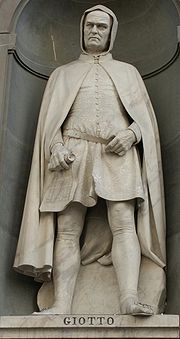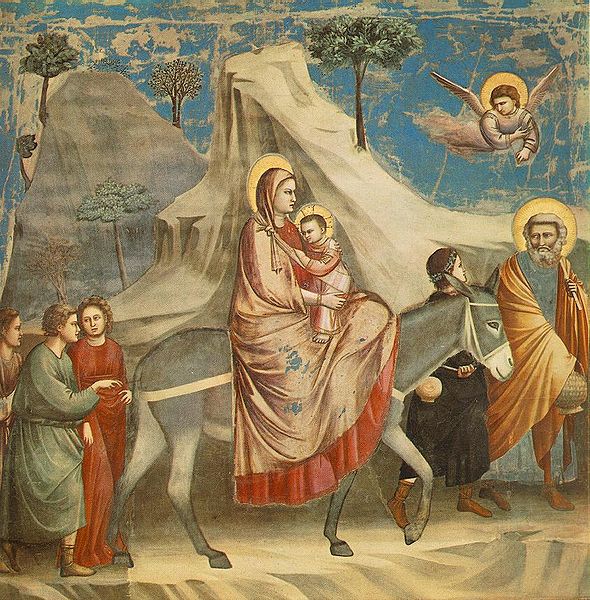Biography of Giotto Di Bondone:
Giotto di Bondone (1266/7 – January 8, 1337), better known simply as Giotto, was a  famous Italian painter and architect from Florence in the late Middle Ages. He is generally considered the first in a line of great artists who contributed to the Italian Renaissance. famous Italian painter and architect from Florence in the late Middle Ages. He is generally considered the first in a line of great artists who contributed to the Italian Renaissance.
Giotto Di Bondone's contemporary, the banker and chronicler Giovanni Villani, wrote that Giotto was "the most sovereign master of painting in his time, who drew all his figures and their postures according to nature. And he was given a salary by the Comune of Florence in virtue of his talent and excellence."
The late-16th century biographer Giorgio Vasari describes Giotto Di Bondone as making a decisive break with the prevalent Byzantine style and as initiating "the great art of painting as we know it today, introducing the technique of drawing accurately from life, which had been neglected for more than two hundred years."
Giotto Di Bondone's masterwork is the decoration of the Scrovegni Chapel in Padua, also known as the Arena Chapel, completed around 1305. This fresco cycle depicts the life of the Virgin and the life of Christ. It is regarded as one of the supreme masterpieces of the Early Renaissance. That Giotto painted the Arena Chapel and that he was chosen by the Comune of Florence in 1334 to design the new campanile (bell tower) of the Florence Cathedral are among the few certainties of his biography. Almost every other aspect of it is subject to controversy: his birthdate, his birthplace, his appearance, his apprenticeship, the order in which he created his works, whether or not he painted the famous frescoes at Assisi, and his burial place.
Mature works of Giotto Di Bondone:
From 1306 to 1311 Giotto Di Bondone was in Assisi, where he painted frescoes in the transept area of the Lower Church, including The Life of Christ, Franciscan Allegories and the Maddalena Chapel, drawing on stories from the Golden Legend and including the portrait of bishop Teobaldo Pontano who commissioned the work. Several assistants are mentioned, including one Palerino di Guido. However, the style demonstrates developments from Giotto Di Bondone's work at Padua.
In 1311 Giotto Di Bondone returned to Florence, A document from 1313 shows his presence in Rome, where he executed a mosaic for the façade of the old St. Peter's Basilica, commissioned by Cardinal Giacomo or Jacopo Stefaneschi and now lost except for some fragments.
Late works of Giotto Di Bondone:
In 1328 the altarpiece of the Baroncelli Chapel in Santa Croce , Florence was completed. This work, previously ascribed to Giotto, is now believed to be mostly a work by assistants, including Taddeo Gaddi who later frescoed the chapel). Giotto was called by King Robert of Anjou to Naples where he remained with a group of pupils until 1333. Few of Giotto's Neapolitan works have survived: a fragment of a fresco portraying the Lamentation of Christ in the church of Santa Chiara, and the Illustrious Men painted on the windows of the Santa Barbara Chapel of Castel Nuovo (which are usually attributed to his pupils). In 1332 King Robert named him "first court painter" with a yearly pension. , Florence was completed. This work, previously ascribed to Giotto, is now believed to be mostly a work by assistants, including Taddeo Gaddi who later frescoed the chapel). Giotto was called by King Robert of Anjou to Naples where he remained with a group of pupils until 1333. Few of Giotto's Neapolitan works have survived: a fragment of a fresco portraying the Lamentation of Christ in the church of Santa Chiara, and the Illustrious Men painted on the windows of the Santa Barbara Chapel of Castel Nuovo (which are usually attributed to his pupils). In 1332 King Robert named him "first court painter" with a yearly pension.
After Naples Giotto stayed for a while in Bologna, where he painted a Polyptych for the church of Santa Maria degli Angeli, and, according to the sources, a lost decoration for the Chapel in the Cardinal Legate's Castle.
In 1334 Giotto was appointed chief architect to Florence Cathedral, of which the Campanile (founded by him on July 18, 1334) bears his name, but was not completed to his design.
Before 1337 he was in Milan with Azzone Visconti, though no trace of works by him remain in the city. His last known work (with assistants' help) is the decoration of Podestà Chapel in the Bargello, Florence.
In his final years Giotto had become friends with Boccaccio and Sacchetti, who featured him in their stories. In The Divine Comedy, Dante acknowledged the greatness of his living contemporary through the words of a painter in Purgatorio (XI, 94–96): "Cimabue believed that he held the field/In painting, and now Giotto has the cry,/ So the fame of the former is obscure." (Biography of Giotto Di Bondone-Italy Oil Painting Artist)
Refer to: http://en.wikipedia.org/wiki/File:Giotto_-_Scrovegni_-_-20-_-_Flight_into_Egypt.jpg
Edited by Kevin from Xiamen Romandy Art Limited.
(Xiamen Romandy Art is a professional oil paintings supplier from China. If you want to convert your photos into high quality oil paintings, or you want the masterpiece oil painting reproductions, please don's hesitate to contact with us.)
Romandy Art Website: http://www.oilpaintingcentre.com
Tags: Biography of Giotto Di Bondone-Italy Oil Painting Artist
|